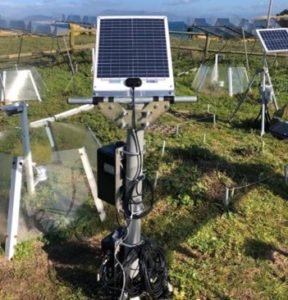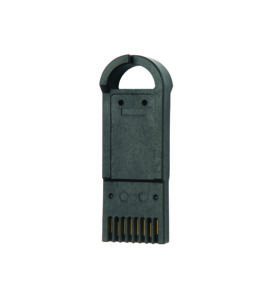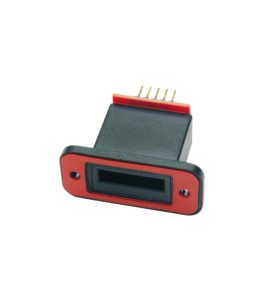GB Electronics (UK) Ltd (GBE) selects Datakey® RUGGEDrive™ UFX tokens and IP67-rated UR4410IM receptacles for use in harsh environment data logging applications.
Data logging in harsh environments is a challenge, especially where environmental monitoring plays an essential role in modern life. Data regarding wind speed, rainfall and temperature in different geographical locations helps meteorologists do their jobs, and data regarding water flow rates in rivers and water levels in reservoirs and underground helps us better understand the mechanics of [and better prepare for] floods and droughts.
However, data logging is often carried out in extremely remote locations and the monitoring systems are exposed to the elements. Accordingly, the same model of data logger might be exposed to the high temperatures and dusts of deserts, the heat and humidity of rain forests and the low temperatures and high winds of mountain tops.

One company at the forefront of environmental monitoring equipment is Surrey-based Van Walt Limited. It supplies a variety of technologies for use in environmental and groundwater monitoring, and one of its leading products is the vanwaltDataHub (see figure 1), a solar-powered data-logger and hub for a wide variety of sensor types.
Vincent van Walt, Director of Van Walt Limited, said: “We developed the vanwaltDataHub in response to our customers’ growing needs for a data collection system that was sensor agnostic and which could communicate over different platforms depending on the site location and availability of a GSM signal. We wanted a system that was flexible, accessible and most importantly reliable.”
Packaged in an IP-rated, rugged enclosure, the unit organises collected data for distribution or sharing through radio frequency, GPRS or satellite portals. Also, following the completion of a recent upgrade programme, the DataHub can copy data to a removable memory device, too.
This is an important new feature as sometimes wireless data transfer is impossible. Also, wireless connectivity draws extra-power – which needs to be managed well on a battery- and solar-powered system.
For this upgrade, Van Walt turned to electronics design company, GBE. Renowned for its embedded systems design capabilities, contract equipment manufacturing (CEM) services and project management skills, the company is active in many sectors including automotive, medical and industrial electronics.
Mark Bullen, Managing Director of GBE, commented: “DataHubs often have to operate in harsh environment remote locations, so unit reliability is a high priority. It was therefore essential that the introduction of the removable memory devices feature did not compromise that reliability.”
It was decided early on that data should be accessed externally, i.e. there should be no need to open up the unit. This would therefore necessitate a receptacle on the exterior of the DataHub.
The use of a standard USB port, in order to accommodate a USB (thumb) drive, was immediately ruled out. Drives and receptacles are not generally available as rugged / industrial versions nor do they offer sufficient security as the USB form-factor is too widely available. However, it was recognised that the USB comms protocol was safe enough to use from an embedded systems perspective.
Reliable Connections

GBE turned to Nexus Industrial Memory, ATEK’s appointed distributor in the UK, Ireland, Germany, Switzerland, Austria and Scandinavia for its Datakey range of products. Datakey have a range of products ideal for data logging in harsh environments.
Matthew Wilson, GBE’s Technical Director, recalled: “I first met Nexus and saw the Datakey tokens at a trade show. Both the products and the company stayed in my mind so, as we mapped out the features for the new vanwaltDataHub, I knew that a bespoke ‘data key’ and a weather- and tamper-proof receptacle would be needed.”
Based on GBE’s requirements, Nexus recommended the Datakey RUGGEDrive UFX token and the IP67-rated UR4410IM receptacle. The token (see figure 2a) provides USB (NAND) flash drive functionality through a USB 2.0 hi-speed interface, and is of a solid over-moulded construction, making it impervious to liquids and virtually crush-proof.
As for the UR4410IM receptacle (again, see figure 2b), it has a standard 5-pin motherboard header and custom mounting features and details to provide enhanced water protection. The receptacle body has a 2-piece construction, comprising a field-proven frame/contact system on the inside and a tough outer shell that provides additional strength and environmental protection. As with all Datakey receptacles, the UR4410IM has corrosion-resistant, gold dot contacts and a detent mechanism that provides a tactile confirmation when an inserted token is physically engaged.

Note: whilst a high insertion/removal cycle figure was not a priority for GBE on this project, the RUGGEDrive UFX and UR4410IM are rated at a minimum of 10,000 cycles, compared to standard USB devices’ figure of 1,500, a further indication of the ruggedness of the Datakey industrial device.
The UR4410IM is mounted on the side of the DataHub’s enclosure panel and, though IP67-rated, for extra protection the receptacle’s opening is beneath a rubber-backed plate. See figure 3.
Innovative Solution
The frequency with which data from the units can be retrieved via the Datakey device depends on the deployment, the environment and sensor and data types.
Wilson went on to explain that the new vanwaltDataHub was designed such that inserting a Datakey token into the unit’s receptacle wakes up the system. “We based this part of our design around the USB specification requirement that a device must indicate its presence and speed with a pull-up resistor on the USB D+ data line. We use a low power microcontroller to watch for such an event and as that is its only responsibility where USB is concerned, we did not have to implement a full USB stack.”
When the microcontroller detects the USB Datakey pull-up, it boots the computer module and relinquishes control of the USB D+ line to the computer module (which does have the full USB stack).
Once booted, the computer module then enumerates the USB Datakey, just like a PC recognising a new device being inserted into a port. If the device is valid – i.e. the expected vendor and product IDs are present – the computer module will then automatically transfer data. Wilson: “The data is in the form of zipped CSV files, so it’s a quick data transfer and we were able to get away with using the 4Gbyte UFX tokens, the smallest in the RUGGEDrive range.”
Wilson went on to explain that configuration files can also be transferred automatically as part of the wake-up. “This gives us a relatively straight-forward method of reconfiguring a Datahub in the field without any additional equipment. Configuration data might include an alarm limit on a channel, or you may wish an action to be taken. For example, DataHubs can be used in greenhouses. If it gets too hot, signals can be provided to drive electronics for opening windows.”
At the end of the transfer the computer module signals the microcontroller, the DataHub sounds its internal sounder to inform the user that the token can be removed. The system then drops back into its low power data logging mode.
Summary

The first vanwaltDataHub unit with the ability to transfer data to and from a RUGGEDrive token was supplied to Van Walt in 2017. Since then many more have followed and, at the time of writing, several hundred are deployed for environmental monitoring applications around the world.
GBE’s engineers created a rugged, reliable and versatile platform when they designed the new DataHub and the addition of new features (implemented largely through software upgrades) is always possible. Such revisions might include the setting of alarms and/or taking actions based on the live data on multiple channels; individually or collectively.
Bullen said: “Nexus provided more than just the physical hardware on this project. They have lots of experience with the USB protocol and helped us get up to speed with host-to-drive communications. Though USB is a standard it can be quirky at times. In this respect, Nexus added real value to the entire project, which is important to us because it’s how we like to be seen by Van Walt. Anyone can supply products, but it’s the service you put around those products that adds real value to the relationship.”
Most recently, GBE and Van Walt have co-operated to produce the Van Walt USB Data Compiler. This is bespoke software that makes sense of the downloaded data from the token and concatenation of the strings so that the data presentation becomes more fluid and more easily readable for customers.
Bullen concluded: “The support from Nexus has been exemplary throughout the entire process and we see them as more of a partner than a supplier.”
To read further coverage of this example of acquiring data in harsh environments in Design Solution’s Magazine visit https://content.yudu.com/web/69r/0A170s4/DSNov20/html/index.html?page=22&origin=reader

